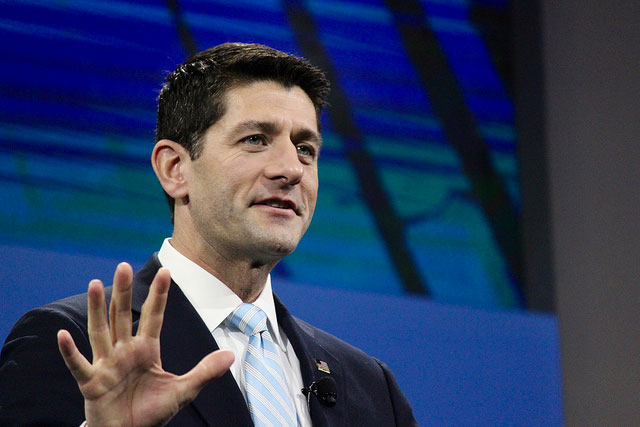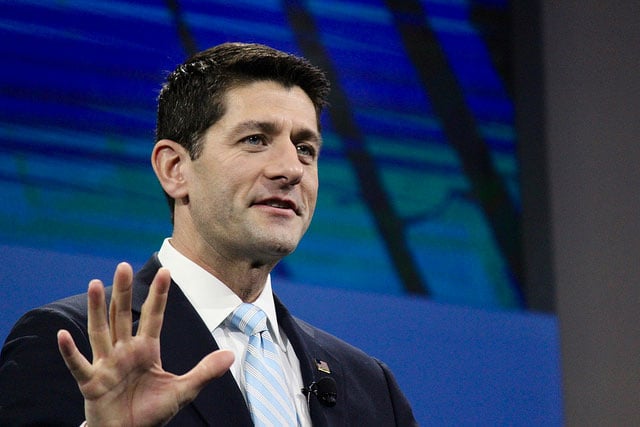
 The rather sketchy plans put forth to date by Republicans such as House Speaker Paul Ryan would not provide enough financial assistance to make coverage affordable, especially for low- and moderate-income people, many of whom would consequently end up uninsured. (Photo: Daniel Huizinga / Flickr)
The rather sketchy plans put forth to date by Republicans such as House Speaker Paul Ryan would not provide enough financial assistance to make coverage affordable, especially for low- and moderate-income people, many of whom would consequently end up uninsured. (Photo: Daniel Huizinga / Flickr)
Republican congressional leaders plan to move quickly in January to repeal the bulk of the Affordable Care Act (ACA) without enacting a replacement plan to prevent the millions of people who have gained coverage through the ACA from becoming uninsured. Instead, the repeal bill will likely delay by two years or more the elimination of the ACA’s Medicaid expansion and subsidies that help low- and moderate-income people buy marketplace coverage. But GOP leaders’ claim that they will enact a replacement plan in the meantime that will be available when the ACA’s coverage provisions expire isn’t credible.
Republican leaders have had six years to put forth a replacement plan that matches the ACA’s coverage and protection from financial risk, and they haven’t done so. The proposals to date from President-elect Trump and congressional Republicans are vague in key respects and would do little to help the millions whose coverage is at risk under ACA repeal to obtain affordable, comprehensive health care. Moreover, many people likely would lose coverage before any Republican health plan was fully implemented.
Repeal Would Leave Market in Disarray
If the repeal bill that congressional GOP leaders passed last year (and President Obama then vetoed) is a guide — as GOP leaders have said it will be — the repeal bill that they bring up for a vote early in 2017 will immediately eliminate the ACA’s individual and employer mandates. This means some people who are now enrolled — particularly healthy people who would no longer have to pay a penalty for lacking coverage — would drop coverage. (Some employers as well could stop offering coverage to their workers.) As a result, it’s likely that some insurers would drop out of the insurance marketplaces in 2018, with those that remain raising their premiums significantly since the people they cover will now be less healthy than in previous years. The premiums could rise to levels that most people who don’t qualify for subsidies cannot afford.
Looking ahead, Republican leaders acknowledge that it will take time to transition to a replacement plan, even after its enactment — which itself may take considerable time. It took four years to implement the ACA after its enactment, and state and federal officials, health care providers, and others are still working to make it operate more smoothly. This timetable would leave consumers, insurers, and the health care community in an extended state of substantial uncertainty, exacerbating disarray in insurance markets.
Moreover, a strategy of repeal without replacement means that policymakers and the public will have no way to judge whether a future GOP plan would provide coverage that’s at least as available, affordable, and adequate as the coverage the ACA provides. The Republican plans that have been offered to date suggest that a future GOP plan is likely to fail on all of these measures.
The rather sketchy Republican plans put forth to date would not provide enough financial assistance to make coverage affordable, especially for low- and moderate-income people, many of whom would consequently end up uninsured. The plans from House Speaker Paul Ryan and House Budget Committee Chair Tom Price, who has been nominated to be the next Secretary of Health and Human Services, would provide tax credits that vary by age but, unlike the ACA, not by income, and wouldn’t take the actual cost of decent-quality coverage into account. The maximum tax credit for people 51 and older in the Price plan would be $3,000 a year, far less than is needed to enable many people with modest incomes to afford coverage in today’s market. This would be particularly problematic for the poor and near-poor who now qualify for coverage under the ACA’s Medicaid expansion and either don’t pay premiums or pay premiums that are very low in relation to their income. Many of them would likely end up uninsured.
While coverage would likely be cheaper under Republican plans, especially for healthier people, that’s because their plans would generally cover significantly fewer benefits and have higher out-of-pocket costs. And sicker people would face big increases in premiums and out-of-pocket costs for deductibles and co-payments, as well as having to bear the full cost of all health care services that their new, less comprehensive plans didn’t cover. In addition, unlike under the ACA, people with low incomes would receive no help with their cost-sharing charges.
Republican Proposals Would Do Little to Help People Losing ACA Coverage
Adding to these concerns, three of the proposals that are listed on President-elect Trump’s transition website, and commonly included in congressional GOP health plans, would do little or nothing to help the millions who stand to lose coverage under ACA repeal:
-
Expanding Health Savings Accounts (HSAs). These accounts, which people with high-deductible health plans can use to set aside money for out-of-pocket health expenses, offer unprecedented tax benefits especially for people with high incomes. Contributions to HSAs are tax deductible, and can be invested in stocks, bonds, or other investments that, once in the HSAs, grow tax-free. In addition, withdrawals from the HSA are entirely tax-exempt as long as they are used for out-of-pocket medical or long-term care costs. HSAs consequently provide one of the more lucrative tax shelters in the U.S. tax code. Unlike contributions to retirement accounts and other tax preferences, both the contributions into the accounts and the subsequent withdrawals from the accounts are tax free.
This unique tax-sheltering opportunity heavily favors higher-income people, both because this tax break rises in value with an individual’s tax bracket and because higher-income people are the people most able to take advantage of this tax shelter and make substantial contributions to these accounts. Most households making contributions to HSAs have incomes of at least $100,000, data from the Joint Committee on Taxation show.
GOP plans to enlarge HSAs and make them an even more lucrative tax shelter would typically allow much larger annual contributions to HSAs. That, too, would primarily benefit high-income people, as they are the individuals most able to make the current maximum annual contribution (the HSA contribution limit is now $3,350 a year for individuals and $6,750 for families), let alone a higher contribution amount. In contrast, people with low incomes usually lack the funds to make significant HSA contributions; they also generally lack the ability to afford the high deductibles that HSA-eligible plans carry.
GOP proposals to expand HSAs typically would also allow people to use their HSAs to pay premiums (currently HSA funds can be used to pay out-of-pocket costs but not premiums). This would make large HSA contributions even more attractive to people with high incomes. Most uninsured people, however, have low- and moderate-incomes and would receive few, if any, tax benefits from an HSA. They would get a tax subsidy of no more than 15 cents on the dollar to purchase health coverage, and those who don’t earn enough to owe federal income tax would get no benefit at all.
-
Expanding high-risk pools. High-risk pools are not a new idea, but rather an approach to providing coverage that’s been proven unsuccessful. Because high-risk pools combine sick people with even sicker people — rather than pooling sick and healthy people together as regular insurance does — they tend to charge extremely high premiums that people can ill afford.
Moreover, states’ experience with state high-risk pools before the ACA shows that even the very high premiums that high-risk pools charge covered only about half of the cost of operating the pools; the rest came from government support. Over time, states with high-risk pools either had to kick in more and more money — or cut their high-risk pools deeply by imposing waiting lists, curtailing benefits, and charging unaffordable premiums. That’s why in 2011, prior to implementation of the ACA’s major coverage provisions, there were a total of only 226,000 people insured nationwide through state high-risk pools, alongside 49 million people who were uninsured.
-
Allowing insurers to sell plans across state lines. Allowing insurers to sell health coverage in other states even if the plans fail to comply with the other states’ consumer-protection requirements would encourage insurers to seek licensure in states where insurance companies are the most powerful politically and consumer protections are the weakest — and then market those plans in other states.
The few states that tried to open their markets to out-of-state insurers prior to health reform generally had little to show for it, as insurers had problems establishing networks of providers outside their own states. But if insurers did succeed in entering other states’ markets, the out-of-state plans would likely attract healthier-than-average people with low health care costs, because such people have much less need for consumer protections such as requirements to cover certain benefits or limits on insurers’ ability to charge higher premiums based on age or gender. As a result, the group of people who remain in plans offered by the in-state insurers would become less healthy as a group, and the premiums that the in-state plans charge then would rise accordingly, making it more difficult for people with medical problems to remain insured.
The ACA has helped tens of millions of Americans gain coverage, even as it has also helped slow the growth in health care costs. The Congressional Budget Office estimated last year, based on the repeal bill that Congress passed and President Obama vetoed in January, that repeal would raise the number of uninsured Americans by at least 22 million.
To be sure, the ACA is far from perfect. Some enrollees face deductibles that are too large relative to their incomes, and millions of uninsured people haven’t enrolled, many of whom are relatively young and healthy and would like more affordable coverage. The top priority for policymakers should be to make health care more affordable, not making it less so or making it entirely unavailable for millions of Americans who now have it.
5 Days Left: All gifts to Truthout now matched!
From now until the end of the year, all donations to Truthout will be matched dollar for dollar up to $50,000! Thanks to a generous supporter, your one-time gift today will be matched immediately. As well, your monthly donation will be matched for the whole first year, doubling your impact.
We have just 5 days left to raise $50,000 and receive the full match.
This matching gift comes at a critical time. As Trump attempts to silence dissenting voices and oppositional nonprofits, reader support is our best defense against the right-wing agenda.
Help Truthout confront Trump’s fascism in 2026, and have your donation matched now!